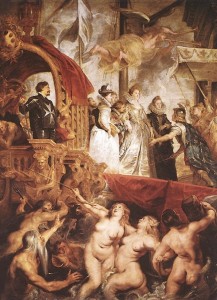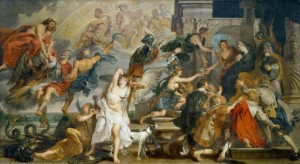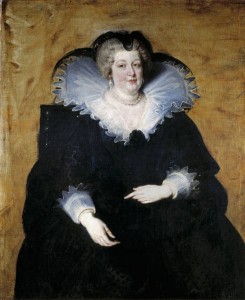The Louvre – Kim Kardashian creates havoc?
Lessons from the Louvre – Part 2: This is the second part of my series on paintings in the Louvre. This is my attempt to cure those suffering from MLS syndrome, and opening your eyes to art highlights other than the Mona Lisa! Over the next month there will be weekly articles on my highlights, which tend not to be the normal selections! If you don’t want to miss out on my next articles on the Louvre please just click on the “Blog Notification” button just to the right.
You wouldn’t imagine finding Kim Kardashian featuring strongly on the gallery walls of the Louvre. Or would you? She just dumped her husband of 70 days to the glare of the world press. People have flocked to news sites to read the latest gossip. But you could go to the Louvre and do exactly the same!
Imagine this. Your Dad who is one of the wealthiest men around decides to get you married off. He finds a dapper unmarried man, pays him a fortune to marry his unattractive daughter. She gets married to him by proxy i.e. he didn’t even turn up, but sent his lawyer to sign the documents! He’s a womaniser and regularly has mistresses on the side – sounds like DSK (Dominique Strauss-Kahn)? She has a child, then quietly arranges his murder, then spends the rest of her life telling everyone how brilliant she is, and terrorising her dead husband’s mistresses and son!! It’d be a good reality TV show!
No I think Kim Kardashian is quite tame compared with what we have here. Nothing can compare with this woman in history who features predominantly in the Louvre!
This story is about the second wife of the great French king, Henri IV. She, Marie de Medici came from one of the wealthiest Italian families. Henri IV was divorced to his previous wife while king, and so the Medicis family arranged for this “business” connection for their daughter. Their child, Louis X111 was born in the first year of their marriage. For the next ten years she was the wife of the King of France, but wanted to be Queen in her own right, and eventually in 1610 she was crowned in St Denis Cathedral in Paris. But you can’t imagine the next step. Within ten hours of her coronation her husband was dead from an assassination, with Marie having arranged his death. She was to rule as Queen Regent of France until her son Louis X111 was of age (15yrs). She refused this transfer of rule to her son, until her son expelled her from Paris to the Loire Valley when he was 17 years old. Upon her expulsion from Paris, she promptly tried unsuccessfully, with the help of another son, to plot the overthrow of Louis X111.
So where does this story fit in to the Louvre.
Eventually her son allowed her back in to Paris in the early 1620s. At this time she began constructing herself a home, which became the Luxembourg Palace (formerly the Medicis Palace), and she wanted to decorate the palace with paintings celebrating her wonderful life!
Marie de Medici commissioned the Flemish painter Paul Rubens to paint two large series of paintings; one to celebrate her life, and one to celebrate that of her dead husband. The latter series was never done! So Paul Rubens ended up painting a series of 24 paintings recounting Marie’s life from her birth, through to her reign – these paintings were enormous being up to 7 metres by 4 metres in size!
But there were two major problems for Paul Rubens. Firstly Marie de Medicis was a most unfortunately unattractive woman, and as she was the one paying the bills it was very difficult for Rubens to portray her in a correct truthful manner. Secondly it was very difficult for the artist to portray this woman who was particularly uninteresting, and never did anything positive or constructive for France.
This series of paintings used to be displayed in the Luxembourg Palace but now can been see in the Louvre. So when you look at this collection of paintings you look at the techniques used by Rubens to try and portray the life of Marie de Medici whilst at the same time always trying not to lie, but also trying to even show her up. There are moments for example where during the wedding scene, at her feet can be seen two dogs that are nonchalantly sitting there licking their private parts, or when viewing her arrival by boat to Marseille, in the front of the scene are three voluptuous nude women who completely take over from the presence of Marie – both clever techniques by the artist at “mocking” his subject matter!

After her wedding in Italy (husband not present!) she arrived in Marseille. Note how the nude voluptuous ladies take over, and Marie is made to not stand out at all.
Below is the largest and most important paintings of all. The purpose of this painting is to show Marie accepting the governance to rule France following her husband’s murder. But you will see it’s not all about Marie! Rubens cleverly features the spirit of Henri IV being carried respectively to heaven – on his way to divine life. Under him is a snake with an arrow threw it, to remind the viewers not to forget that there is a more sinister side to the story. On the other side of the painting Marie is looking fairly insignificant but has the people “celebrating” her ascendency to power, which must have made her feel really good. But if the painting is to celebrate Marie, why is she such an insignificant part of the painting – Rubens is hard at work here!

On the left of this you can see Henri IV ascending to heaven while the people of France celebrate her ascendency to rule France - Paul Rubens really "crawls" to Marie here. We are reminded that Henri has been killed - you can see the snakes with arrows under Henri - just don't forget you arranged his murder!! Copyright Musee du Louvre
These 24 paintings form what is known as the Medicis Cycle and appear in the Louvre in one room exclusively. When you visit here there is no fighting for camera position, as you will be lucky to hardly see anyone in the room. Sit back and study in detail the life of this reality star of the 17th century, but while looking, understand and observe the humour and struggles of the painter Paul Rubens. I find the series hugely entertaining and impressive, and ask you to make an effort to visit.
To find the Medicis cycle in the Louvre:
Richelieu wing, 2nd Floor, Room 18


